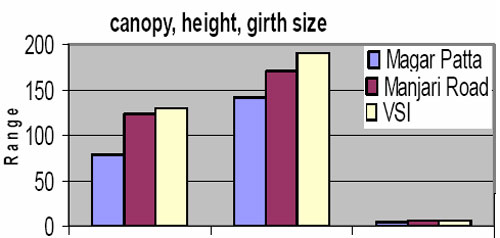Land Area Requirement per Sapling Land Area Requirement per Sapling
It is recommended to have a 2 x 2 ft dug up for plantation of avenue trees which are usually the best choice of the authorities for greening of any city or even for the road side plantation. Accordingly, 2 sq. ft area per plant has been considered for PlantationAdditional Land Requirement for Achieving Desired Greenery
considering a conservative cost of Rs. 500/ plant i.e. (per 2 sq. ft) Cost of land additionally required to achieve desired greenery is : 4,00,000 * 500 = Rs. 200,00,000Indirect Economic Loses Indirect Economic Loses
Enormous indirect loses due to vegetation loses such as carbon sequestration, energy loses through requirement for cooling houses, soil erosion, health effects due to reduced deposition of dust, etc which have been not yet assessed on an urban scale all at a time.Loses Due to Health Effects Loses Due to Health Effects
On average approximately 9.8 tons/day of PM10 had been removed by trees in the Chicago area, improving the average hourly air quality by 0.4% (2.1% in heavily wooded areas). Similar studies considered in Sacramento, USA, regarding a new plantation of trees estimated that 30 year average annual deposition of PM10 per 100 trees was 13.5 kg; The calculations in Philadelphia showed that the tress had removed approximately 418 tonnes of PM10 in 1994, improving air quality by 0.72%. Additionally, 20% loss in the wooded area due to urbanization in Los Angeles would lead to a 14% increase in ozone concentrationsThe change in health effect, mortality or morbidity for a given pollutant is calculated
As dHMT = DR * POLLUT * POP * RATE * 1/100
Where:
dHMT = change in mortality due to forestry foliage;
DR = dose–response coefficient (i.e. 0.075);
POLLUT = net reduction in pollution due to forestry foliage;
POP = population of the 1 km2;
RATE = morbidity or mortality rate for the 1 km2.
The factor 1/100 converts percentages to absolute numbers.

Canopy area (in cm2) Height (cm) Girth size (cm)
- In high traffic area the dust loaded per plant is 0.0032 gm /cm2 whereas the canopy area in Pune is calculated to be approximately 42000000m2, = 32 gm/m2 * 42000000 m2 = 1344 * 106 gm of PM10 deposited on the entire canopy area of Pune vegetation
- Thus, there is a direct reduction in deposition of about 1344 * 103 kgs of PM10 annually which would have been otherwise deposited on the vegetation.
- Asian studies showing about 0.5% increase for every 10µg/m3 increase in PM10 concentration has been adopted for the present study
Cost of Health Losses Due to Mortality
- Approximately 22µg/m3 PM10 reduction will occur through deposition of 1334 tons of PM10 annually on the canopy area of 42 sq. km lost due to air pollution Thereby Change in mortality = 0.075 * 22 * 10526 * 0.5 * 0.01 = 86.84 = ~87
- Thus, approximately 87 deaths would have been avoided if expected canopy area would have been achieved without the loss of vegetation due to air pollution.
- Depending upon the US: India GDP ration equivalent to Purchase Power Parity the same is estimated to be approximately $ 1,76,900.
- The total monetary loses towards mortality due to health effects of PM10 is estimated as: = 87 (Deaths) * 1,76,900 (USD) * 40 (Rupees) = Rs. 61,56,12,000
